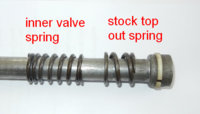XSLeo/solo2, don't pat yourself too much on the back....
You are sort of right, provided there is one installed from the factory, and the stock (too soft) fork spring is retained.
As I said in my original post, I have a 1977, which I believe is the first year with the 35 mm fork.
I asked Jerry Heiden about this, and he confirmed that the early 35 mm forks came WITHOUT a top out spring.
This was introduced on later versions of the 35 mm fork.
Also there was no top out spring in my fork when I dismantled it, which confirmed the info I got from Heiden.
And my XS did indeed have a very annoying "clunk" when accelerating hard. Which I like to do fairly often.
So I am going to take my forks apart, and install top out springs. I may even use a longer than stock top out spring, to lower the front slightly, maybe 20-25 mm. In my opinion, using a longer top out spring is a better way to lower the front than solid spacers (like HHB offers)
Also, the top out spring rate needs to be considered when altering fork spring rates and pre-load. Using the Racetech spring rate calculator, I end up with a 0.9kg/mm spring rate and 15 mm pre-load, while the spec for the stock spring is 0.56 kg/mm, pre-load unknown.
Obviously, the force trying to compress the top out spring is very much depending on the pre-load as well as spring rate.
In any case, the top out spring is not doing much good if it is bottomed out completely. It needs to have some "reserve" travel in order to absorb the kinetic energy from the extending fork as well.
The stock top out springs are very soft, I suspect too soft. Especially with a stiffer fork spring and maybe more pre-load lie mentioned above. 0.9 kg/mm and 15 mm results in a "force" of 13,5 kg (actually 132,6 Newton, which is used for measuring force) This will surely compress the OEM top out springs a lot, if not completely (will check and report back)


